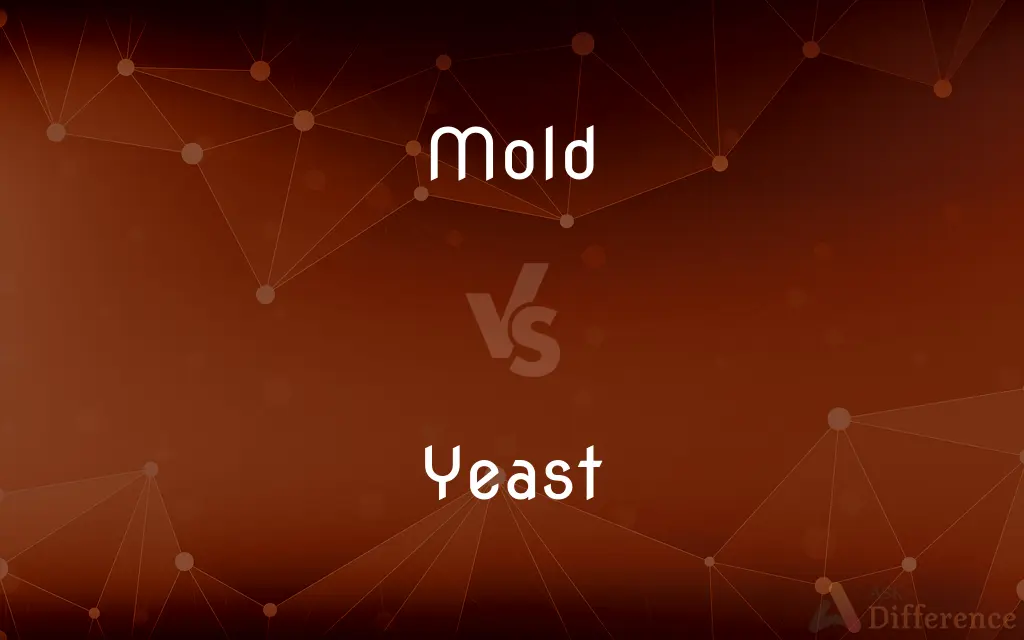Mold vs. Yeast — What's the Difference?
By Tayyaba Rehman — Updated on October 5, 2023
Mold is a multicellular fungus that appears in various colors and fuzzy patches, while yeast is a unicellular fungus often used in baking and brewing. Both are fungi, but with distinct structures and functions.

Difference Between Mold and Yeast
Table of Contents
ADVERTISEMENT
Key Differences
Mold and yeast, both being fungi, share similarities but are fundamentally different in many aspects. Mold is multicellular and consists of filaments called hyphae, forming visible colonies. It can be seen on decaying food and damp surfaces, manifesting as fuzzy or slimy patches. The presence of mold indicates spoilage, decay, or dampness, and it plays a crucial role in the decomposition process in ecosystems.
Yeast, contrastingly, is unicellular and has been beneficial to humans for millennia, especially in baking and alcohol production. These single-celled organisms consume sugars and produce carbon dioxide, resulting in the rising of dough or fermentation in alcoholic beverages. Yeast cells are much smaller than mold colonies and usually aren't visible to the naked eye unless they're in large clusters.
Interestingly, molds produce spores that are air-borne and can spread easily, leading to rapid colonization. On the other hand, yeast reproduces by a process called budding, where a daughter cell grows out of the parent cell. This means molds are often seen as invasive and can sometimes cause health problems, especially for those with respiratory issues.
On the topic of colors, molds can appear in a rainbow of colors - black, green, white, or even orange. Yeast typically has a consistent off-white or creamy appearance. While certain molds can be harmful and produce mycotoxins, yeasts, especially the ones used in food production, are safe and even beneficial for consumption.
Both mold and yeast have their unique places in nature and human activities. While mold is generally associated with decay and decomposition, yeast's connotation leans towards culinary and brewing practices. Nevertheless, they both remain critical components of the fungal kingdom.
ADVERTISEMENT
Comparison Chart
Cellular Structure
Multicellular, with hyphae
Unicellular
Appearance
Fuzzy or slimy patches in various colors
Creamy, off-white clusters
Reproduction
Produces airborne spores
Reproduces by budding
Common Uses
Decomposition, some cheeses, antibiotics
Baking, brewing, fermentation
Health Implications
Can cause allergies, produce mycotoxins
Generally safe; used as probiotics
Compare with Definitions
Mold
A growth indicating spoilage or decay.
The damp wall had mold growing on it.
Yeast
A fungus used for fermentation.
The yeast fermented the grape juice into wine.
Mold
Substance used in food or medicine production.
Blue cheese contains edible mold.
Yeast
A single-celled microorganism aiding in dough rising.
She added yeast to make the bread fluffy.
Mold
A cavity used to shape materials.
He poured the liquid metal into a mold.
Yeast
An agent causing expansion or growth.
The yeast in the dough makes it expand.
Mold
A pervasive influence or quality.
She was a teacher in the truest mold.
Yeast
A source of vitamins and minerals.
Nutritional yeast is a popular vegan cheese substitute.
Mold
A mold (US) or mould (UK, NZ, AU, ZA, IN, CA, IE) is a fungus that grows in the form of multicellular filaments called hyphae. In contrast, fungi that can adopt a single-celled growth habit are called yeasts.
Yeast
A critical component in brewing beer.
The brewer selected a specific yeast for flavor.
Mold
A town in north-eastern Wales, administrative centre of Flintshire; population 10,500 (est. 2009).
Yeast
Yeasts are eukaryotic, single-celled microorganisms classified as members of the fungus kingdom. The first yeast originated hundreds of millions of years ago, and at least 1,500 species are currently recognized.
Mold
A hollow form or matrix for shaping a fluid or plastic substance.
Yeast
A microscopic fungus consisting of single oval cells that reproduce by budding, and capable of converting sugar into alcohol and carbon dioxide.
Mold
A frame or model around or on which something is formed or shaped.
Yeast
Any of various unicellular fungi of the genus Saccharomyces, especially S. cerevisiae, reproducing asexually by budding or sexually through the production of ascospores and capable of fermenting carbohydrates.
Mold
Something that is made in or shaped on a mold.
Yeast
Any of numerous fungi that exhibit a one-celled growth form and reproduce by budding, including certain candidas that can cause infections in humans.
Mold
The shape or pattern of a mold.
Yeast
Froth consisting of yeast cells together with the carbon dioxide they produce in the process of fermentation, present in or added to fruit juices and other substances in the production of alcoholic beverages.
Mold
General shape or form
The oval mold of her face.
Yeast
A powdered or compressed commercial preparation of yeast cells, used chiefly as a leavening agent or as a dietary supplement.
Mold
Distinctive character or type
A leader in the mold of her predecessors.
Yeast
An agent of ferment or activity
Political agitators who are the yeast of revolution.
Mold
A fixed or restrictive pattern or form
A method of scientific investigation that broke the mold and led to a new discovery.
Yeast
An often humid, yellowish froth produced by fermenting malt worts, and used to brew beer, leaven bread, and also used in certain medicines.
Mold
(Architecture) See molding.
Yeast
A single-celled fungus of a wide variety of taxonomic families.
Mold
Any of various filamentous fungi that grow on and contribute to the decay of organic matter.
Yeast
A true yeast or budding yeast in order Saccharomycetales.
Mold
A growth of such fungi.
Yeast
Candida, a ubiquitous fungus that can cause various kinds of infections in humans.
Mold
Any of various other saprophytic or parasitic organisms that resemble fungi, such as slime molds or water molds.
Yeast
(figuratively) A frothy foam.
Mold
Loose friable soil, rich in humus and fit for planting.
Yeast
To ferment.
Mold
The earth; the ground.
Yeast
(of something prepared with a yeasted dough) To rise.
Mold
The earth of the grave.
Yeast
To exaggerate.
Mold
(Archaic) Earth as the substance of the human body.
Yeast
The foam, or troth (top yeast), or the sediment (bottom yeast), of beer or other in fermentation, which contains the yeast plant or its spores, and under certain conditions produces fermentation in saccharine or farinaceous substances; a preparation used for raising dough for bread or cakes, and making it light and puffy; barm; ferment.
Mold
To form (something) out of a fluid or plastic material
Molded a cup out of clay.
Yeast
Spume, or foam, of water.
They melt thy yeast of waves, which marAlike the Armada's pride, or spoils of Trafalgar.
Mold
To form into a particular shape; give shape to
Molded the clay into a ball.
Yeast
A form of fungus which grows as individual rounded cells, rather than in a mycelium, and reproduces by budding; esp. members of the orders Endomycetales and Moniliales. Some fungi may grow both as a yeast or as a mycelium, depending on the conditions of growth.
Mold
To guide or determine the growth or development of; influence
A teacher who helps to mold the minds of his students.
Yeast
A commercial leavening agent containing yeast cells; used to raise the dough in making bread and for fermenting beer or whiskey
Mold
To fit closely by following the contours of (the body). Used of clothing.
Yeast
Any of various single-celled fungi that reproduce asexually by budding or division
Mold
To assume a certain shape
Shoes that gradually molded to my feet.
Mold
To become moldy.
Mold
A hollow form or matrix for shaping a fluid or plastic substance.
Mold
A frame or model around or on which something is formed or shaped.
Mold
Something that is made in or shaped on a mold.
Mold
The shape or pattern of a mold.
Mold
General shape or form.
The oval mold of her face
Mold
Distinctive character or type.
A leader in the mold of her predecessors
Mold
A fixed or restrictive pattern or form.
His method of scientific investigation broke the mold and led to a new discovery.
Mold
(architecture) A group of moldings.
The arch mold of a porch or doorway;
The pier mold of a Gothic pier, meaning the whole profile, section, or combination of parts
Mold
(anatomy) A fontanelle.
Mold
A natural substance in the form of a woolly or furry growth of tiny fungi that appears when organic material lies for a long time exposed to (usually warm and moist) air.
Mold
A fungus that creates such colored, furry growths.
Mold
Loose friable soil, rich in humus and fit for planting.
Mold
Earth, ground.
Mold
The top or crown of the head.
Mold
(transitive) To shape in or on a mold; to form into a particular shape; to give shape to.
Mold
(transitive) To guide or determine the growth or development of; influence
Mold
(transitive) To fit closely by following the contours of.
Mold
(transitive) To make a mold of or from (molten metal, for example) before casting.
Mold
(transitive) To ornament with moldings.
Mold
(intransitive) To be shaped in or as if in a mold.
These shoes gradually molded to my feet.
Mold
(transitive) To cause to become moldy; to cause mold to grow upon.
Mold
(intransitive) To become moldy; to be covered or filled, in whole or in part, with a mold.
Mold
To cover with mold or soil.
Mold
A spot; a blemish; a mole.
Mold
Crumbling, soft, friable earth; esp., earth containing the remains or constituents of organic matter, and suited to the growth of plants; soil.
Mold
Earthy material; the matter of which anything is formed; composing substance; material.
The etherial mold,Incapable of stain.
Nature formed me of her softest mold.
Mold
A growth of minute fungi of various kinds, esp. those of the great groups Hyphomycetes, and Physomycetes, forming on damp or decaying organic matter.
Mold
The matrix, or cavity, in which anything is shaped, and from which it takes its form; also, the body or mass containing the cavity; as, a sand mold; a jelly mold.
Mold
That on which, or in accordance with which, anything is modeled or formed; anything which serves to regulate the size, form, etc., as the pattern or templet used by a shipbuilder, carpenter, or mason.
The glass of fashion and the mold of form.
Mold
Cast; form; shape; character.
Crowned with an architrave of antique mold.
Mold
A group of moldings; as, the arch mold of a porch or doorway; the pier mold of a Gothic pier, meaning the whole profile, section, or combination of parts.
Mold
A fontanel.
Mold
A frame with a wire cloth bottom, on which the pump is drained to form a sheet, in making paper by hand.
Mold
To cover with mold or soil.
Mold
To cause to become moldy; to cause mold to grow upon.
Mold
To become moldy; to be covered or filled, in whole or in part, with a mold.
Mold
To form into a particular shape; to shape; to model; to fashion.
He forgeth and moldeth metals.
Did I request thee, Maker, from my clayTo mold me man?
Mold
To ornament by molding or carving the material of; as, a molded window jamb.
Mold
To knead; as, to mold dough or bread.
Mold
To form a mold of, as in sand, in which a casting may be made.
Mold
The distinctive form in which a thing is made;
Pottery of this cast was found throughout the region
Mold
Container into which liquid is poured to create a given shape when it hardens
Mold
Loose soil rich in organic matter
Mold
The process of becoming mildewed
Mold
A fungus that produces a superficial growth on various kinds of damp or decaying organic matter
Mold
Sculpture produced by molding
Mold
Form in clay, wax, etc;
Model a head with clay
Mold
Become moldy; spoil due to humidity;
The furniture molded in the old house
Mold
Form by pouring (e.g., wax or hot metal) into a cast or mold;
Cast a bronze sculpture
Mold
Make something, usually for a specific function;
She molded the riceballs carefully
Form cylinders from the dough
Shape a figure
Work the metal into a sword
Mold
Fit tightly, follow the contours of;
The dress molds her beautiful figure
Mold
Shape or influence; give direction to;
Experience often determines ability
Mold public opinion
Mold
A fungus forming multicellular filaments.
The bread was covered in green mold.
Common Curiosities
Can you see yeast with the naked eye?
Yeast cells are microscopic, but in large clusters, they can be seen as creamy patches.
How does yeast make bread rise?
Yeast ferments sugars, releasing carbon dioxide which makes the dough expand.
Can mold grow on any surface?
Mold typically grows on damp or organic surfaces with adequate warmth.
Can you use any yeast for baking?
Specific yeasts are best for baking, like Saccharomyces cerevisiae.
Is mold always harmful?
While some molds can be harmful, others are used in food production like blue cheese.
How can you prevent mold growth?
By keeping areas dry, well-ventilated, and free from organic debris.
Is there a connection between mold and allergies?
Yes, mold spores can trigger allergic reactions in sensitive individuals.
Are both mold and yeast fungi?
Yes, both mold and yeast belong to the fungal kingdom.
How is yeast used in beer making?
Yeast ferments the sugars in grains, producing alcohol and carbonation.
How does yeast reproduce?
Yeast reproduces by a process called budding.
Do both mold and yeast need moisture to grow?
Yes, both mold and yeast thrive in moist environments.
Are all molds dangerous to consume?
Not all. Some molds, like those in certain cheeses, are safe to eat.
Does mold only grow on food?
No, mold can grow on various surfaces, especially if they're damp.
Can molds produce harmful substances?
Some molds produce mycotoxins, which can be harmful if ingested.
Why is yeast beneficial in the human diet?
Yeast is a source of vitamins, minerals, and can act as a probiotic.
Share Your Discovery

Previous Comparison
Audience vs. Attendance
Next Comparison
Superior vs. SupervisorAuthor Spotlight
Written by
Tayyaba RehmanTayyaba Rehman is a distinguished writer, currently serving as a primary contributor to askdifference.com. As a researcher in semantics and etymology, Tayyaba's passion for the complexity of languages and their distinctions has found a perfect home on the platform. Tayyaba delves into the intricacies of language, distinguishing between commonly confused words and phrases, thereby providing clarity for readers worldwide.
















































